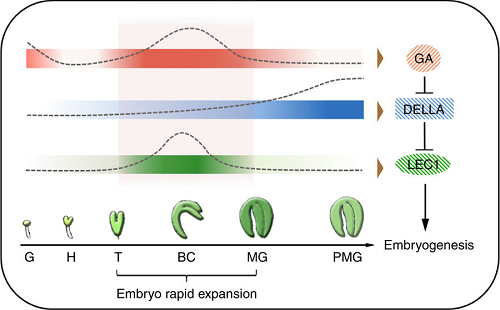The plant hormone gibberellin (GA) plays key roles in almost all aspects of plant development, but its detailed function and underlying regulatory mechanism in embryo development are not yet clearly defined.
Recently, a research team led by Prof. Hou Xingliang from South China Botanical Garden (SCBG) of the Chinese Academy of Sciences discovered an essential role of GA in late embryogenesis of Arabidopsis. Bioactive GAs showed a distinct synthetic peak during the cotyledon and embryonic axis expansion stage. During this period, deficiency in GA biosynthesis or signaling results in an abnormal embryo phenotype characterized by less-developed cotyledons and shortened embryo axis. In contrast, GA overdose leads to a significantly larger mature embryo.
DELLA proteins are the negative regulators in the GA signaling pathway. Researchers revealed that DELLA interact with LEAFY COTYLEDON1 (LEC1), the key regulator in late embryogenesis. Further analyses found that GA triggers the degradation of DELLAs to relieve their repression on LEC1, thus promoting auxin accumulation to facilitate embryo development.
Taken together, these findings not only uncover a spatio-temporal specific role of GA in regulating late embryogenesis through the GA–DELLA–LEC1 signaling cascade, but also provide us with a novel mechanistic understanding of how phytohormones regulate embryogenesis.
The study entitled "Gibberellins play an essential role in late embryogenesis of Arabidopsis" was recently published in Nature Plants. Article link: https://www.nature.com/articles/s41477-018-0143-8

Fig. A proposed model for gibberellin-regulated late embryogenesis
